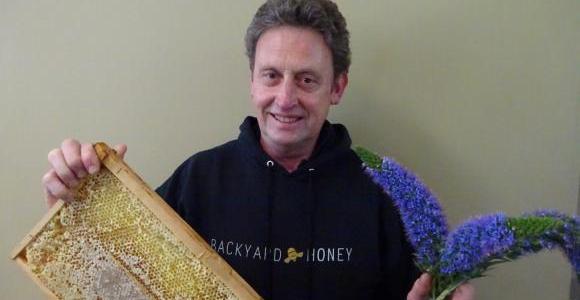
Honey and Beekeeping
You are here

Peter Dyer
Thursday, 11 October, 2018
Peter Dyer, an apiarist spoke about backyard bee keeping.
About rural apiarists who own thousands of bee hives and must transport their hives great distances between orchards and areas of native flowering plants. Hives are moved to North Victorian almond trees and then onto orange orchards around Mildura and Southern N.S.W. The purpose of which assists the orchard grower with producing abundant crops and the apiarist to harvest large amounts of honey for commercial purposes.
For the backyard enthusiast with 1 beehive, a suburban backyard could possibly provide a beehive of bees with enough pollen, if the garden is thoughtfully planted with a variety of plants that will flower at different times throughout the year. Bees can travel up to 7k a day to collect pollen and make 5 million flower visits to make 1kg of honey.
Peter demonstrated the set-up of the beehive. The brood box is the bottom storey in the hive, this is where the queen lays her eggs and the workers tend the young. Over the top is a wire grid with narrow slits to prevent the queen from entering the upper hive so no eggs are laid there.
Above the brood box hang the vertical frames. The frames can be taken out to extract the honey. Peter showed members the frames with honey sealed with wax stored in the frames.
Peter said the 2 main requirements to having a beehive in the backyard are:- 1. The beehive must be placed 3 metres away from the neighbours fence. 2. Plentiful supply of fresh water close to the beehive.
Bees are able to maintain a stable temperature of 30 degrees in the hive year round. In winter they huddle together inside to keep the hive warm and in high summer temperatures, they collect water and spread outside to use an evaporative method to cool the hive.
The queen bee will mate once in her lifetime of 4-5 years and will lay up to 2,000 eggs a day during spring. She produces pheromones, chemical emissions to keep the worker bees sterile and stop the development of new queens. While she can produce them, the queen remains in control of the hive. When the queen begins to lose vigour, the workers will create a new queen. If a new queen emerges, the two queens will either fight to the death, or the old queen leaves with a swarm of about half the bees in the colony to begin a new hive. When the bees are preparing to swarm and leave the hive, they will gorge themselves on honey to prepare for their journey. Peter said it was important to collect a swarm of bees very early, as while they are full of honey they are reasonably docile and will become more hostile when they become hungry. For this reason Peter asked all members to record his phone No. 0425 873 555, to report a bee swarm as early as possible.
The varroa mite infestations are found all over the world, except Australia, with thanks to our strict security and quarantine rules.
Peter answered members questions and provided jars of honey for sale and kindly donated a jar of honey to raffle.
For further information email peter@backyardhoney.com.au or go to








